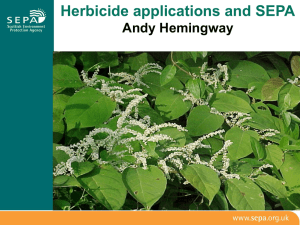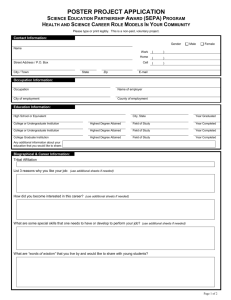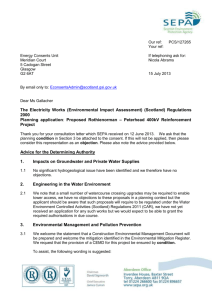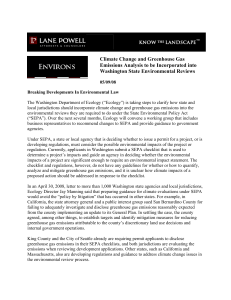Summary of the “Getting Involved” Consultation
advertisement
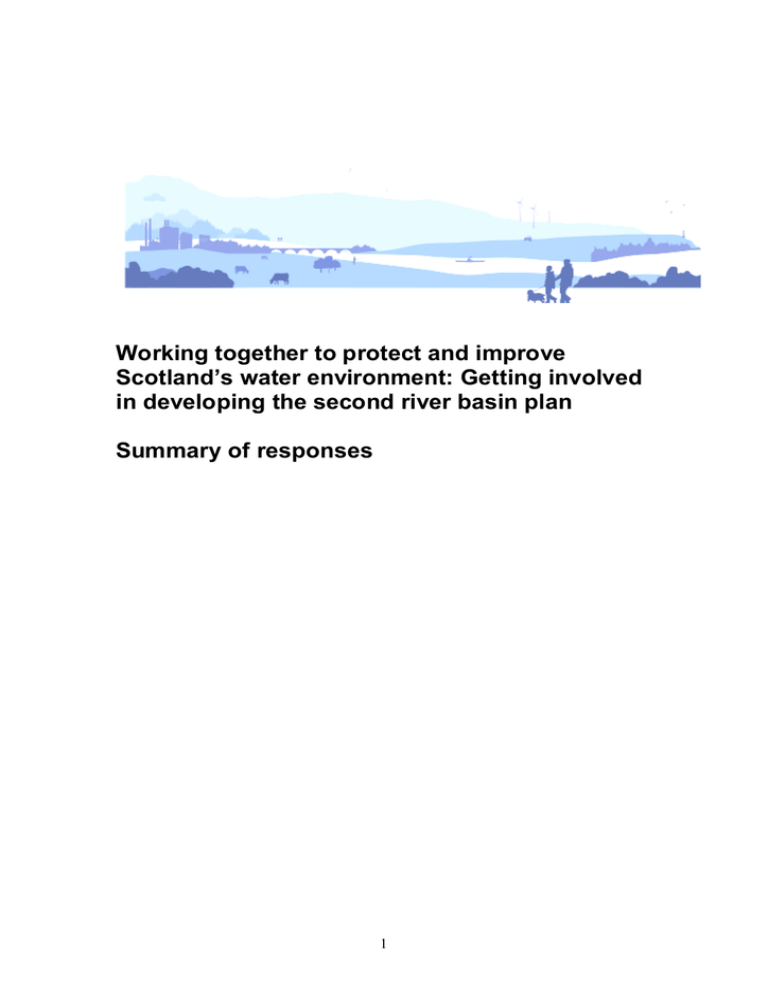
Working together to protect and improve Scotland’s water environment: Getting involved in developing the second river basin plan Summary of responses 1 1.0 Introduction Between 31 August 2012 and 28 February 2013, the Scottish Environment Protection Agency (SEPA) consulted on engagement for the development of the second river basin management plan (RBMP) for the Scotland river basin district1. This digest summarises the comments received during the consultation and the actions that will be taken as a result. A consultation for the Solway Tweed 2 district ran in conjunction with the Scotland document. The Solway Tweed summary of responses has also been published and is available on the SEPA website3 and Environment Agency website4. The consultation document was developed with considerable input from RBMP Advisory Group members between November 2011 and May 2012. The positive responses received reflect this engagement. SEPA would like to thank everyone who took the time to respond to the consultation, and appreciate the continued interest and support in delivering river basin planning across the Scotland district to protect and improve our water environment. 2.0 Summary of responses Eighteen responses were received, over half of which were responsible authorities. A list of respondents can be viewed in Table1 and copies of the responses are available upon request. The responses received were detailed and well informed in the RBMP process and its application. The comments were very supportive of the ways SEPA is currently working with stakeholders and provided additional suggestions of actions that SEPA and others could take that would improve the way we work together as we move toward the second cycle. Table 1. Respondents to the consultation 2012-2013 Organisation * denotes shared response with Solway Tweed Forestry Commission Scotland East Dunbartonshire Council Royal Society for the Protection of Birds* Orkney Council Scottish Natural Heritage Cromarty fisheries board and trust Association Salmon Fishery Boards and Scottish Land & Estates* Rivers and Fisheries Trusts of Scotland* Scottish Water* Migdale Smolt Ltd. Scottish Southern Energy Scottish Anglers National Association Perth and Kinross Council Micro Hydropower Association* Kyle and Sutherland DSFB Royal Yachting Association* City of Edinburgh Council Stirling Council 1 www.sepa.org.uk/about_us/consultations/closed_consultations.aspx www.sepa.org.uk/about_us/consultations/closed_consultations.aspx 3 www.sepa.org.uk/water/river_basin_planning.aspx 4 https://consult.environment-agency.gov.uk/portal/ho/wfd/working/together2012 2 2 The responses are summarised into the following themes: Engagement and partnership working. Developing the catchment approach. Benefits to people and climate change. 3.0 Engagement and partnership working Approximately half of the respondents felt restricted in contributing to the process, stating that resources, staff time and funding were constraining factors. This highlights the necessity to continue to strive for increased efficiency and effectiveness of engagement as we move towards the second cycle. Respondents to the consultation agreed that the proposed engagement opportunities for the development of the second plan are sufficient and proportionate. Suggestions to improve the process included; expanding the circulation of consultations to nonstatutory consultees to broaden the level of expertise and incorporat e a general any other suggestions question to allow respondents to input all their suggestions. Coordination of RBMP activities with other processes was suggested to avoid clashes in consultation deadlines and ease the burden on stakeholders. Response: SEPA and the Scottish Government are committed to the continuous active engagement of a wide range of stakeholders. The scale SEPA engages at (river basin district, sub-basin district, catchment, sector and issue based and frequency of meetings) is being reviewed to ensure: engagement is timed to be effective; we make best use of stakeholder and SEPA resources. The clear message about the need for both effective communication and resource efficiency from the consultation responses, (including the relatively low number of responses received) has been taken into account in our proposed approach to the consultation on the second river basin management plan for the Scotland river basin. SEPA and the Scottish Government now intend to prepare a consultation on the changes to the river basin management plan rather than produce a complete draft second plan. This will allow for a focused and effective engagement on the areas where feedback is required, so stakeholders can efficiently contribute to the development of the second plan. Non-statutory consultees were used for the first RBMPs and will be included as an option for the second plan. SEPA has worked throughout the first cycle to ease the process with pre consultation engagement, questions integrated into documents, an online consultation tool and extended consultation periods. They will continue to work to ease this process for future consultations. 3.1 Advisory groups Respondents were very supportive of the advisory groups, highlighting that they are effective in identifying matters of local significance and engaging directly with local groups. It was highlighted that the area advisory groups (AAGs) give a sense that stakeholders are moving together towards a common goal. Increased interaction and 3 correspondence between the various advisory groups was suggested to better inform stakeholders, share experience and develop implementation. A key message from respondents is that AAGs should focus on delivering action at a catchment scale within their areas. Working at a catchment scale within AAGs will help ensure that local engagement opportunities are maximised. Respondents were also supportive of the proposals to expand upon the work of AAG sub-groups to engage a wider audience and focus on the delivery of measures. The Diffuse Pollution Management Advisory Group (DPMAG) was praised for its success. It was suggested that the expertise within this group could be used to influence and formulate policy. A suggestion was made to expand this work and create an advisory group for urban diffuse pollution. Concern was raised by one respondent that the membership of the Fish and Fisheries Advisory Group (FFAG) was not representative. Response: SEPA is committed to expanding and developing of catchment scale working with sub-groups and will continue to support and develop this work in the second cycle. SEPA and the Scottish Government will initiate a review of the need to create an advisory group for urban diffuse pollution during 2013. The role of the FFAG group, its remit and membership are currently being reviewed, the comments made will be taken into consideration during this review. The outcomes of this review will be published before the end of 2013. 3.2 Changes to advisory boundaries Scotland has adopted a new approach to the management of flood risk through the Flood Risk Management (Scotland) Act 20095 (FRM Act). Co-ordinating engagement between RBMP and FRM processes, combined with experience operating the AAGs over the last six years, has led to propose changes to the existing AAG boundaries. These were discussed in detail with the AAGs prior to the consultation and are fully supported by the responses received. One response raised concern that the scale of the north Highland area could inhibit local engagement and it was suggested that the effectiveness of this area should be reviewed if necessary. It was also suggested that future consideration may also need to be given to the marine region boundaries. Response: The proposed boundary changes will be applied from autumn 2013. 3.3 Engaging wider stakeholders Respondents were positive about continuing to use and expand engagement using the workshop approach, stating that previous events had been worthwhile exercises that bring together a range of perspectives 6. Respondents were also supportive of the suggested methods to expand stakeholder engagement through the use of partnership events and awareness raising, although 5 www.sepa.org.uk/flooding.aspx A list of workshop topics suggested can be provided on request by emailing: rbmp@sepa.org.uk 6 4 concern was raised regarding resource implications and previous attendance levels at similar events. It is hoped this work will expand local partnership working, improve dissemination of information and result in increased implementation. Response: SEPA intend to continue to integrate their work efficiently with stakeholders planning timetables and are reliant on effective communication streams to be maintained to do this. SEPA and the Scottish Government are currently planning how objectives and the programme of measures for the second plans will be developed. The suggestions from this consultation will be used to inform that process. 3.4 Sharing data with partners Respondents highlighted the importance of data sharing and the need for robust, easily interpreted data to help inform environmental decision making 7. Response: SEPA is committed to improving accessibility to information to assist stakeholders in their ability to deliver RBMP objectives. The feedback received during the consultation will be used to review information available on the SEPA website. SEPA also intend to use an external stakeholder group to help scope data needs and appropriate presentation techniques to ensure they are fit for purpose. Improvements to the data are expected to be implemented by 2015. 3.5 Linking planning processes All the respondents agreed that integration facilitates the delivery of multiple benefits whilst maximising efficiencies in stakeholder efforts. Respondents also agreed to the importance of linking specifically with flood risk management, marine spatial plan and water shortage plans. It was proposed in the consultation responses that SEPA and Marine Scotland use the two pilot marine planning regions to trial the links between river basin planning and marine planning processes. As well as continuing to work to integrate RBMP with flooding and marine planning there are also opportunities to expand integration with local authorities as responsible authorities. The responses received from local authorities support this and were very positive about progress made to embed RBMP principles within land use planning systems. Working together on strategic and local development plans has been very useful to develop management approaches and use of a common language. A focus on engaging with existing local partnerships and stakeholders, such as local biodiversity partnerships, could also increase effectiveness. Response: SEPA, the Convention of Scottish Local Authorities (COSLA) and Heads of Planning Scotland (HoPS) are looking to work in partnership with Scottish Government to develop policy guidance and utilise existing national planning forums to take forward RBMP objectives. Briefing notes and standard presentations will be prepared to raise awareness of RBMP issues with relevant local authority functions, determine and communicate a prioritised set of measures and work on these with individual local authorities. 7 A list of suggestions regarding data can be provided on request by emailing: rbmp@sepa.org.uk 5 Work to link river basin planning and marine planning processes is underway and will be developed in conjunction with Scottish Coastal Forum and Marine Scotland to integrate the two processes. 4.0 Developing the catchment approach The proposals to expand working at the catchment scale were greatly supported by all respondents. This message was also strengthened by the responses received to the consultation on the supplementary plan; Improving the physical condition of Scotland’s water environment 8. The digest to this consultation is due to be published this summer. The local authority responses support planning and profiling at a catchment scale. This approach links well with other ‘multiple benefit’ initiatives such as the green networks and the requirement to formulate ‘spatial’ strategies in development plans, such as land allocations, that individually and cumulatively could lead to a deterioration in the water environment.This is particularly true for individual catchment projects where wider dissemination of the information about pressures, to these existing partnerships, could improve effectiveness by directing local project delivery. Responses suggested the establishment of project working groups to address local issues as they arise, reinforcing the sub-group implementation strategy previously mentioned. The success of the diffuse pollution priority catchment work9 was highlighted by respondents as successful and effective catchment scale approach. The pilot catchment project launched10 in 2013 was also commented upon as a good example. This project is expanding our understanding of this approach by investigating whether we can deliver measures to improve the physical condition of the water environment and contribute to reducing flood risk. Some responses said they were keen to be involved in selecting catchments to ensure projects are started where there is a commitment to drive the project to completion. It was acknowledged that catchment scale work is resource heavy and further financial and institutional support would be required if this work is to be expanded upon. Response: SEPA and the Scottish Government are committed to the expansion of the catchment approach. The process required to develop this work has been discussed at the NAG, who are keen to continue to influence the national strategic direction of this approach as part of second plan development. SEPA is also committed to the continuation of diffuse pollution priority catchments into the second cycle. They are also committed to taking forward the outputs of existing and emerging catchment initiatives across Scotland, including multiple benefits projects in the Clyde and Forth areas, supporting catchment-scale invasive non-native species projects11 and numerous others. 8 www.sepa.org.uk/about_us/consultations/closed_consultations.aspx www.sepa.org.uk/water/diffuse_pollution.aspx 10 www.sepa.org.uk/water/river_basin_planning/implementing_rbmp.aspx 11 www.rafts.org.uk/bio-security-and-invasive-non-native-species/ 9 6 5.0 Benefits to people and climate change We all enjoy the benefits of a clean, healthy water environment for the economic, social and environmental benefits it provides. We are increasingly aware that these benefits are under pressure from climate change and the demands of an increasing population. Respondents are in agreement that there must be increased effort to protect and improve the health of the water environment in a sustainable way in order that these benefits continue. It was suggested that as well as adapting to climate change we should, in line with EU, UK and Scottish Government policy, promote mitigation measures for climate change in the second plan. One respondent suggested that the Scottish Environment LINK’s principles for climate change adaptation 12 should be applied. Response: SEPA is currently assessing the benefits provided by our environment in order to inform prioritisation of measure implementation for the second cycle. SEPA will continue to work with the Scottish Government to safeguard against the effects of climate change and integrate this into the second plan. 6.0 Next steps SEPA will be working with the Scottish Government, advisory groups and the responsible authorities to develop the suggestions from the consultation responses and integrate them into the second plan. Workshops will be held on relevant topics during this process. These improvements will further develop efficient and effective progress and enhance engagement as the second river basin management plans take shape. There are two key milestones before the publication of the second plan in 2015: The current condition of the water environment in relation to its target condition will be assessed and published at the end of 2013 in the Current condition and challenges for the future report. At the end of 2014 SEPA will be consulting on the changes that are proposed for the second plan that will be published in 2015. 12 www.scotlink.org/public/work/taskforce.php?id=20 7 8


